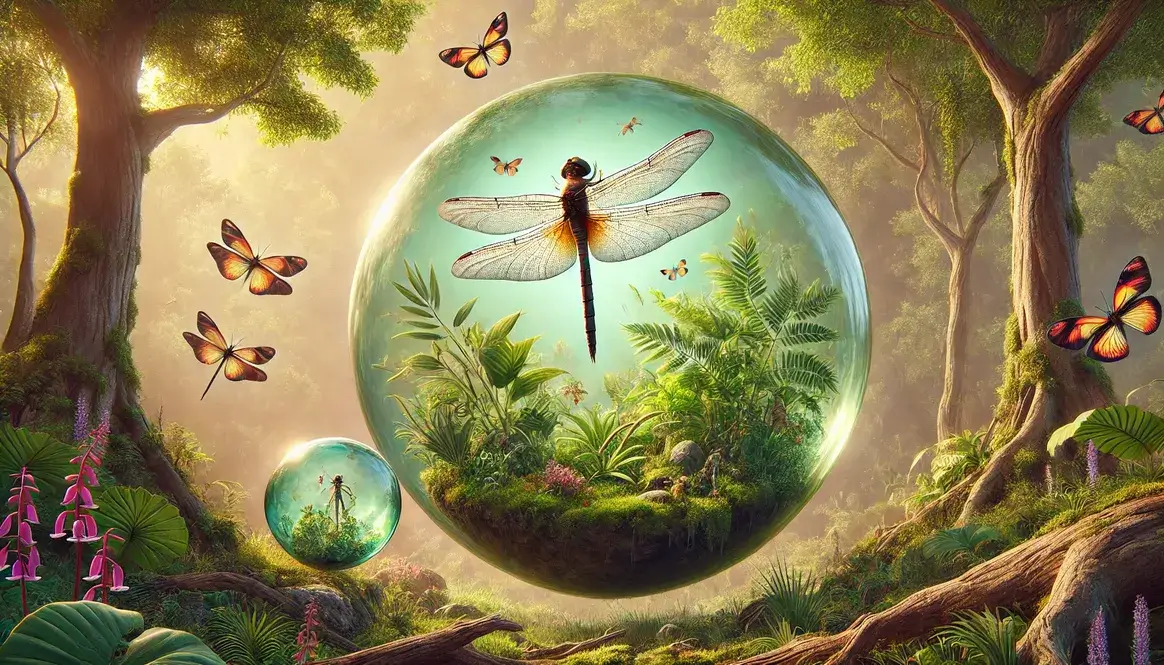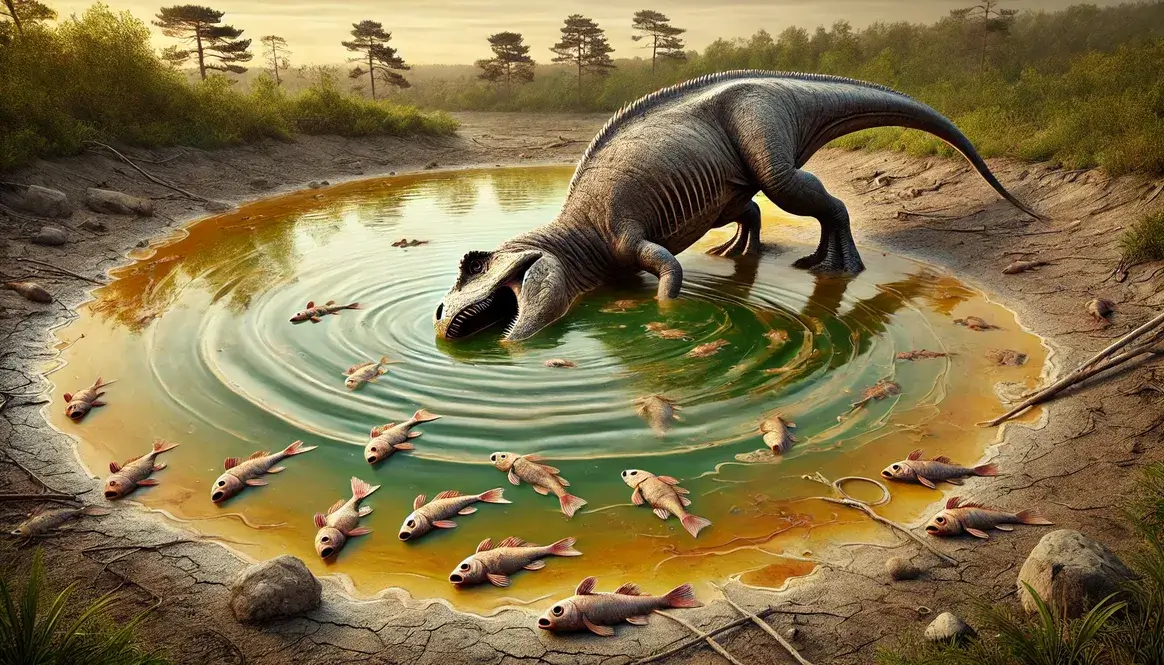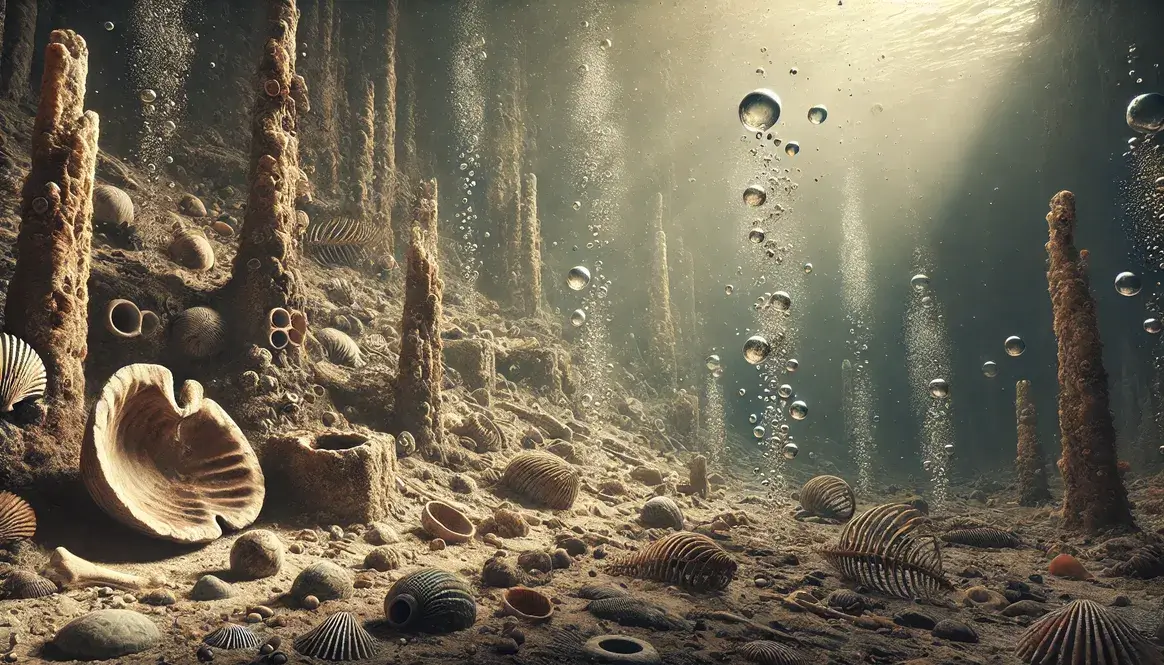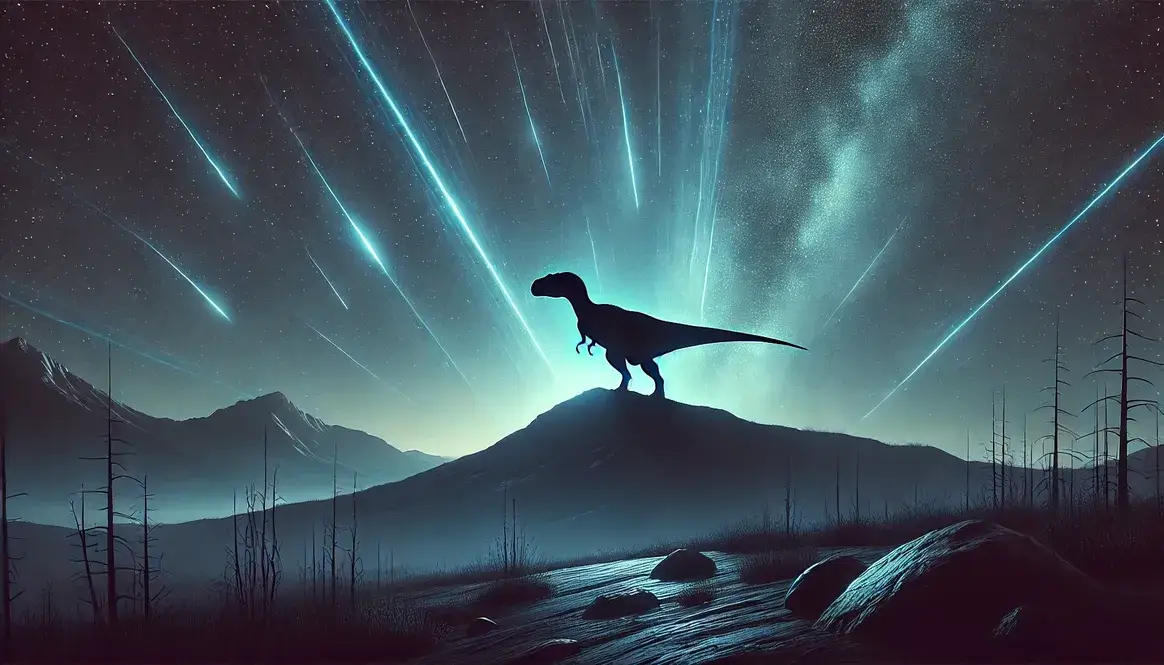The Cretaceous food chain collapse marks one of the most significant breakdowns of Earth’s ecosystems. This massive disruption affected all living things, from the smallest plants to the largest predators, leading to widespread extinctions and fundamental changes in how animals and plants interacted with each other.
| Key Aspects of the Cretaceous Food Chain Collapse | Impact on Ecosystem |
|---|---|
| Primary Producers (Plants & Phytoplankton) | 75% decline in plant species |
| Herbivorous Dinosaurs | 90% reduction in large plant-eaters |
| Carnivorous Dinosaurs | Loss of 95% of large predators |
| Marine Life | 70% decline in ocean species |
| Recovery Time | Over 1 million years |
What Was the Late Cretaceous Ecosystem?
Before the collapse, the Late Cretaceous period featured some of the most complex and stable food chains in Earth’s history. These ecosystems supported an extraordinary variety of life, from giant plant-eating dinosaurs to fierce predators.
The food chain worked like a pyramid:
- At the bottom: Plants and tiny organisms called phytoplankton formed the foundation
- In the middle: Plant-eating animals, including many types of dinosaurs that lived in the Cretaceous
- At the top: Meat-eating dinosaurs and other predators
Energy moved through this system in a specific way:
- Plants captured energy from the sun
- Plant-eaters got their energy by consuming these plants
- Predators obtained energy by hunting other animals
This stable system supported some remarkable animals:
| Trophic Level | Examples | Role in Ecosystem |
|---|---|---|
| Primary Producers | Flowering plants, Conifers | Created food from sunlight |
| Primary Consumers | Triceratops, Edmontosaurus | Ate plants and spread seeds |
| Secondary Consumers | Tyrannosaurus rex, Velociraptor | Controlled herbivore populations |
| Decomposers | Bacteria, Fungi | Recycled nutrients |
The climate during the Cretaceous helped maintain this balance. Warm temperatures and high carbon dioxide levels supported lush plant growth, which in turn fed large populations of plant-eating dinosaurs. These herbivores then sustained numerous predator species.
This intricate system remained stable for millions of years until various factors began to disrupt it. These disruptions would eventually lead to one of the most significant ecological collapses in Earth’s history.
The Cretaceous Food Chain Collapse
A food chain collapse happens when multiple parts of an ecosystem break down at the same time. During the Cretaceous-Paleogene extinction event, this breakdown happened rapidly and affected all living things.
The first signs that something was wrong appeared in the ocean ecosystems. Scientists studying the ancient marine environments have found evidence that tiny sea creatures started dying off in large numbers. This was just the beginning of a chain reaction that would spread through all ecosystems.
Key Warning Signs of the Collapse:
- Sudden changes in plant communities
- Decline in the number of small animals
- Changes in predator behavior
- Unusual patterns in fossil formation
| Timeline of Collapse | Signs of Ecosystem Stress |
|---|---|
| Early Warning Phase | Changes in plant growth patterns |
| Initial Collapse | Marine ecosystem disruption |
| Main Phase | Large animal populations decline |
| Final Stage | Complete ecosystem restructuring |
The timing of this collapse lined up with several other major events. While volcanic activity in India was already causing problems, the situation became much worse when an asteroid struck Earth. These events triggered a series of environmental changes that made it hard for many species to survive.
Some unusual factors also played a role in the collapse. For example, toxic metals in the environment made it harder for plants to grow, while changes in oxygen levels affected many animals’ ability to survive.
These combined factors created what scientists call a “cascade effect” – when one part of the ecosystem fails, it causes other parts to fail too, like dominoes falling one after another. The speed of this collapse was particularly devastating, giving species little time to adapt to the rapidly changing conditions.
Primary Producers: The Foundation Falls
When ecosystems start to fail, the problems often begin with primary producers – the organisms that make their own food through photosynthesis. During the Cretaceous food chain collapse, both land plants and ocean organisms faced severe challenges.
Plant Community Changes
The first flowering plants had just become common when disaster struck. Within a short time, many plant species disappeared completely. Scientists studying ancient plant fossils have found clear evidence of this crisis.
Major changes in plant communities included:
- Reduced photosynthesis due to darkened skies
- Mass die-off of large trees
- Loss of many flowering plant species
- Survival of only the hardiest species
| Plant Type | Survival Rate | Recovery Time |
|---|---|---|
| Large Trees | Less than 10% | 100,000+ years |
| Ferns | About 50% | 1,000 years |
| Ground Cover | About 30% | 10,000 years |
| Flowering Plants | Less than 20% | 50,000+ years |
These changes severely affected plant-eating dinosaurs, who suddenly found their food sources vanishing. Many herbivores had specialized diets, eating only certain types of plants. When these plants disappeared, the dinosaurs couldn’t survive.
Marine Phytoplankton Crisis
In the oceans, an even more severe crisis unfolded. Tiny organisms called phytoplankton, which form the base of marine food chains, began dying in massive numbers. The Cretaceous ocean ecosystems faced unprecedented disruption.
Evidence of this crisis appears in:
- Layers of sediment lacking microfossils
- Changes in ocean chemistry
- Mass extinctions of marine animals
The effects rippled through the marine food chain:
- Phytoplankton populations crashed
- Small filter-feeding animals died out
- Larger marine predators lost their food sources
- Entire ocean ecosystems collapsed
Ocean acidification effects made the situation even worse, preventing many marine organisms from building their shells and skeletons. This crisis in the oceans would last for thousands of years, fundamentally changing marine ecosystems forever.
Scientists studying microfossils have found that it took over 100,000 years for marine productivity to return to normal levels. Some types of phytoplankton went extinct completely, while others evolved to fill new roles in the changed oceans.
Effects on Plant-Eaters
When plants began disappearing, plant-eating dinosaurs faced a severe food shortage. These herbivores, which had thrived for millions of years, suddenly found themselves struggling to survive.
Large Herbivore Decline
The largest plant-eaters suffered the most. Duck-billed dinosaurs and other massive herbivores needed huge amounts of food each day. When plant life declined, they couldn’t find enough to eat.
The effect on different herbivore groups:
| Herbivore Type | Daily Food Needs | Survival Challenge |
|---|---|---|
| Sauropods | 1,000+ kg | Extreme |
| Hadrosaurs | 200-500 kg | Severe |
| Ceratopsians | 100-300 kg | High |
| Small Herbivores | Less than 50 kg | Moderate |
Long-necked sauropod dinosaurs were particularly vulnerable because they:
- Required massive amounts of plant material
- Had specialized feeding habits
- Couldn’t adapt quickly to new food sources
Fossil evidence shows that different regions experienced varying rates of herbivore extinction. Areas with more diverse plant life sometimes provided temporary refuges where some species survived longer.
Small Herbivore Response
Smaller plant-eaters had certain advantages during this crisis. Their lower food requirements and ability to eat a wider variety of plants helped some survive longer than their larger relatives.
Key survival factors for small herbivores:
- Lower daily food needs
- More flexible diets
- Better ability to hide from predators
- Easier to find shelter
The early mammals living during this time demonstrated remarkable adaptability. Many could eat both plants and insects, which helped them survive when plant life became scarce.
Scientists studying fossil evidence have found that smaller species generally had better survival rates. Body size played a crucial role – animals weighing less than 25 kilograms had the best chance of making it through the crisis. This pattern of survival would shape the evolution of life for millions of years to come.
Some small herbivores even developed new ways of feeding, such as eating bark or roots when their usual food sources disappeared. These adaptations allowed certain species to survive while larger plant-eaters vanished completely.
Predator Population Effects
As plant-eaters died out, meat-eating dinosaurs faced their own crisis. The collapse of prey populations led to fierce competition and dramatic changes in hunting behavior.
Large Carnivore Crisis
The biggest hunters suffered tremendously. T. rex and other predators needed tons of meat to survive. With fewer prey animals available, these massive carnivores couldn’t find enough food.
Impact on Major Predator Groups:
| Predator Type | Main Prey | Survival Duration After Crisis Started |
|---|---|---|
| Large Theropods | Large herbivores | Less than 1,000 years |
| Medium Carnivores | Mixed prey | 2,000-3,000 years |
| Small Hunters | Small prey | Some survived |
| Scavengers | Dead animals | Many survived |
Scientists studying carnivorous dinosaur fossils have found evidence of:
- Increased competition for food
- Unusual wear on teeth from eating bone
- Signs of malnutrition
- Population decline in all large species
Changes in Hunting Patterns
When traditional prey became scarce, surviving predators had to change their hunting strategies. Meat-eating dinosaur groups that could adapt their diets had better chances of survival.
New hunting patterns emerged:
- Targeting smaller prey
- Eating unusual food sources
- Increased scavenging
- More aggressive competition
Competition between predators intensified as food became scarce. Fossil evidence shows unusual patterns of injury, suggesting more frequent fights between carnivores over limited food resources.
Some smaller predators found success by:
- Hunting in groups
- Eating eggs and small animals
- Developing more efficient hunting methods
- Expanding their hunting territories
The most successful hunters were those that could eat many different types of prey. This flexibility helped some species survive longer as the ecosystem continued to break down.
Evidence suggests that some predators even resorted to cannibalism during this time, showing how desperate conditions became. The last surviving large predators likely disappeared within a few thousand years of the initial collapse, leaving only their smaller, more adaptable relatives to carry on.
Evidence in the Fossil Record
Scientists have found extensive evidence of the Cretaceous food chain collapse in rocks and fossils from this time period. These discoveries tell a detailed story of how ecosystems fell apart.
Bone Bed Findings
Famous Cretaceous fossil sites contain layers filled with bones from many different animals that died around the same time. These mass death assemblages provide clear evidence of the ecosystem collapse.
Patterns Found in Bone Beds:
| Layer Type | What It Shows | Time Period |
|---|---|---|
| Normal Layers | Regular dinosaur diversity | Before collapse |
| Crisis Layers | Sudden mass deaths | During collapse |
| Recovery Layers | Few species, small animals | After collapse |
| Empty Layers | Almost no fossils | Long-term aftermath |
Scientists studying different kinds of fossils have noticed interesting patterns:
- More young animals than usual
- Signs of malnutrition on bones
- Unusual groupings of species
- Evidence of population stress
Chemical Evidence
Chemical analysis of fossils provides additional proof of the collapse. Studying ancient bones reveals changes in animal diets and health during this time.
Scientists can tell what animals ate by studying different forms of carbon and nitrogen in their fossils. These studies show:
- Changes in plant-eater diets
- Switching to less nutritious plants
- Eating unusual food sources
- Signs of starvation
- Predator diet shifts
- More varied prey species
- Evidence of scavenging
- Increased stress markers
The K-Pg boundary layers contain unusual amounts of certain chemical elements, showing how dramatically the environment changed. These changes affected the entire food web, from the smallest plants to the largest predators.
Nutrient stress appears in several ways:
- Unusual mineral content in bones
- Changes in growth patterns
- Evidence of disease
- Signs of healing injuries
This chemical evidence helps scientists understand not just what happened during the collapse, but also how quickly these changes occurred and how they affected different species in different ways.
Speed and Pattern of Collapse
The breakdown of Cretaceous food chains happened at different speeds in different places. While some areas experienced rapid collapse, others showed a more gradual pattern of ecosystem failure.
Scientists studying how climate changed rapidly have mapped out how quickly different parts of the food chain failed:
| Ecosystem Level | Time to Collapse | Initial Impact |
|---|---|---|
| Ocean Surface | Days to weeks | Severe |
| Land Plants | Weeks to months | Catastrophic |
| Large Herbivores | Months to years | Extreme |
| Top Predators | 1-3 years | Fatal |
| Small Animals | Variable | Moderate |
Different regions experienced the collapse in different ways. Areas closer to the Chicxulub impact site faced immediate devastation, while more distant locations showed a slower pattern of decline.
The sequence of ecosystem breakdown:
- First Wave (Immediate)
- Death of surface ocean life
- Massive plant die-offs
- Loss of large herbivores
- Second Wave (Within Months)
- Collapse of marine food chains
- Widespread forest deaths
- Extinction of specialized species
- Final Wave (1-3 Years)
- Loss of top predators
- Complete ecosystem restructuring
- Survival of only the most adaptable species
Areas near rivers and lakes often preserved pockets of life longer than open areas. These water sources provided refuge for some species, though even these safer zones eventually felt the effects of the collapse.
The speed of the collapse left little time for species to adapt. Changes in the land happened so quickly that even the most adaptable animals struggled to survive. This rapid change helps explain why so many species disappeared forever during this time.
Surviving Species
Some animals managed to live through the Cretaceous food chain collapse, though not by accident. These survivors shared specific traits that helped them endure the harshest conditions Earth had seen in millions of years.
Successful survivors typically had these features:
- Small body size (under 25 kg)
- Flexible diets
- Ability to hide or burrow
- Fast reproduction rates
| Survival Strategy | Example Species | Success Factor |
|---|---|---|
| Burrowing | Small mammals | Protected from extreme temperatures |
| Omnivorous Diet | Early birds | Could eat multiple food types |
| Hibernation | Crocodilians | Reduced food needs |
| Small Size | Lizards | Required less food |
Animals that survived developed various ways to adapt. Some early mammals competed with dying dinosaurs by eating new types of food and staying active at night.
Recovery happened in stages:
- Initial survival phase (first 100 years)
- Early recovery (1,000-10,000 years)
- New ecosystem development (100,000+ years)
Life Finds a Way
The Cretaceous food chain collapse changed life on Earth forever. While many species disappeared, the survivors became ancestors of many animals alive today. Through studying this ancient crisis, scientists have learned valuable lessons about how ecosystems can fall apart – and how life eventually recovers.
The effects by region of this collapse still influence modern ecosystems. Many of today’s familiar animals, from birds to mammals, only had their chance to thrive because they survived this massive breakdown of ancient food chains.
This reminds us that even the most devastating changes can lead to new beginnings, though recovery takes time and the world that emerges looks very different from what came before.









